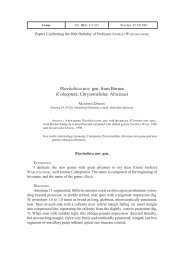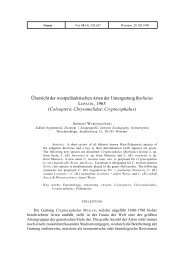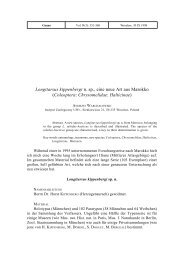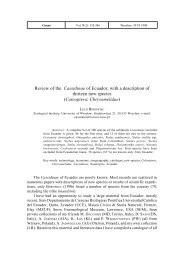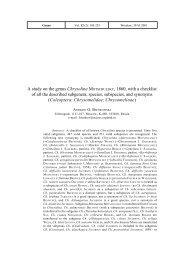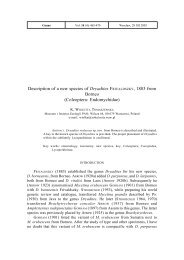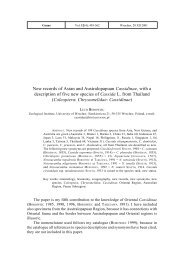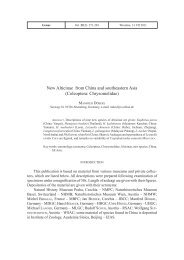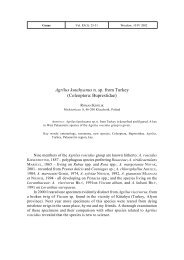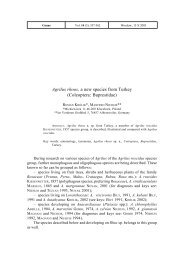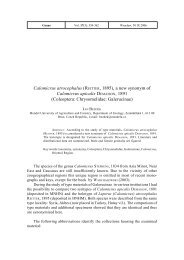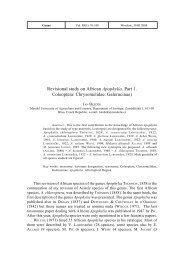Studies on asiatic Apophylia. Part 5: Revisional study of type ...
Studies on asiatic Apophylia. Part 5: Revisional study of type ...
Studies on asiatic Apophylia. Part 5: Revisional study of type ...
Create successful ePaper yourself
Turn your PDF publications into a flip-book with our unique Google optimized e-Paper software.
486 JAN BEZDÌK<br />
TYPE MATERIAL EXAMINED<br />
The <strong>type</strong> material was not studied.<br />
ADDITIONAL MATERIAL EXAMINED<br />
CHINA: SE Tibet, R<strong>on</strong>g Tö valley, 6500 ft., 23.v.1933, E. KINGDON WARD &<br />
R. J. H. KAULBACK leg. (1/0 in BMNH); SE Tibet, Zayul, Atakang, 9000 ft.,<br />
9.vi.1933, E. KINGDON WARD & R. J. H. KAULBACK leg. (1/0 in BMNH); same data,<br />
17.vi.1933 (0/1 in BMNH); same data, 8000 ft., 17.vii.1933 (2/0 in BMNH)<br />
COMMENTS<br />
The <strong>type</strong> material was not examined. According to the original descripti<strong>on</strong>, A.<br />
e. elschotziae was based <strong>on</strong> 30 specimens from Tibet deposited in the Institute <strong>of</strong><br />
Zoology, Academia Sinica, Peking, China (CHEN 1976). Unfortunately, the paper<br />
with descripti<strong>on</strong> <strong>of</strong> A. elschotziae is written in Chinese, with very short English<br />
summary <strong>on</strong>ly. I have found 5 specimens <strong>of</strong> A. e. elschotziae within the undetermined<br />
<strong>Apophylia</strong> material from BMNH and I decided to redescribe A. e. elschotziae<br />
as follows.<br />
DIAGNOSIS<br />
A. elschotziae elschotziae can be distinguished from its c<strong>on</strong>geners by the<br />
unique structure <strong>of</strong> antennae and by the structure <strong>of</strong> aedeagus (Fig. 8).<br />
REDESCRIPTION<br />
Body flattened, parallel-sided, densely pubescent, dull.<br />
Head black, mouthparts and clypeal margin brown. Pr<strong>on</strong>otum yellow with<br />
median black spot. Scutellum and underside black. Antennomeres 1 to 8 yellowish<br />
to brownish, gradually darkened, antennomere 1 infuscate dorsally, antennomeres<br />
9 to 11 black. Femora black, tibiae and tarsi yellow, occasi<strong>on</strong>ally infuscate. Elytra<br />
metallic green.<br />
Labrum transverse, covered by 6 pale setae in row, anterior margin sinuate.<br />
Anterior part <strong>of</strong> head semiopaque, covered by microsculpture, vertex dull, coarsely<br />
and densely puntcured. Interantennal space with small deep groove c<strong>on</strong>tinuing<br />
between fr<strong>on</strong>tal tubercles and to vertex as gradually narrowed impunctate stripe.<br />
Fr<strong>on</strong>tal tubercles large, subtriangular, distinctly elevated above vertex, lustrous.<br />
Vertex densely covered by short pale hairs. Antennae robust, 0.85 times as l<strong>on</strong>g as<br />
the body, length ratio <strong>of</strong> antennomeres 1 to 11: 18:9:15:22:17:16:10:15:7:7:15.<br />
Antennomere 8 largely extended, antennomeres 9 and 10 very short, triangularlike.<br />
Pr<strong>on</strong>otum transverse, 1.8 times as broad as l<strong>on</strong>g, widest at the first third,<br />
str<strong>on</strong>gly narrowed posteriad, semiopaque, densely covered by coarse punctures<br />
and pale hairs. Surface with two deep transverse depressi<strong>on</strong>s and two small feeble<br />
depressi<strong>on</strong>s in the posterior corners. Anterior and posterior margins slightly<br />
sinuate, lateral margins distinctly sinuate in posterior half. All margins indis-



